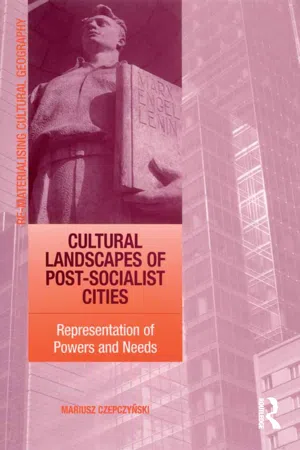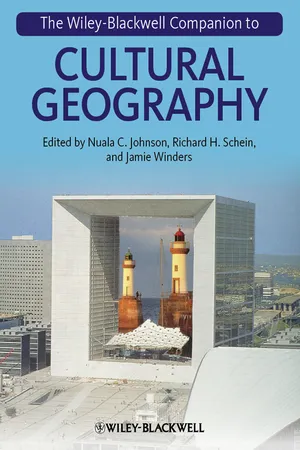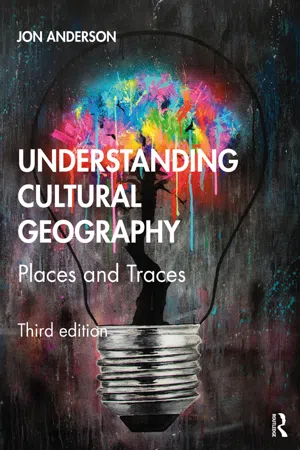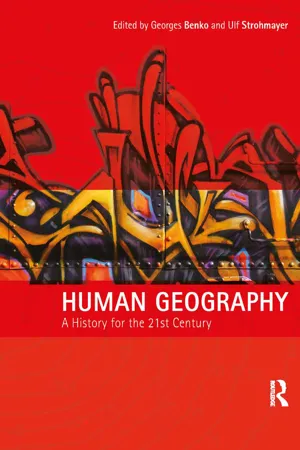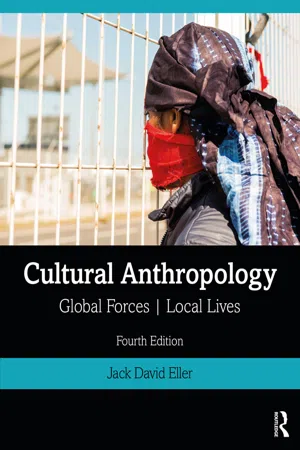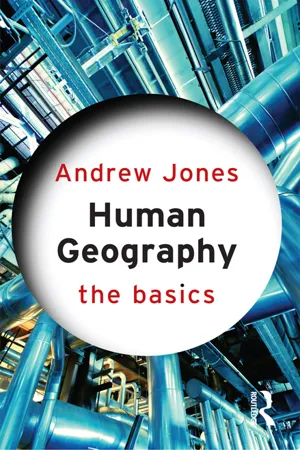Geography
Definition of Culture
Culture refers to the shared beliefs, customs, traditions, and behaviors of a particular group of people. It encompasses language, religion, food, art, and social norms, shaping the way individuals interact with their environment. In geography, culture plays a crucial role in influencing the landscape, settlement patterns, and the distribution of human activities.
Written by Perlego with AI-assistance
Related key terms
Related key terms
1 of 4
Related key terms
1 of 3
11 Key excerpts on "Definition of Culture"
- eBook - ePub
Cultural Landscapes of Post-Socialist Cities
Representation of Powers and Needs
- Mariusz Czepczynski(Author)
- 2016(Publication Date)
- Routledge(Publisher)
The broad definition of ‘culture’ meets post-modern demand for an elastic meta-idiom, used more and more often by journalists, writers and researchers. Like ‘landscape’, ‘culture’ is a notoriously elastic concept and often defined as a signifying system through which ‘a social order is communicated, reproduced, experienced and explored’ (Williams 1982, 13). It involves the conscious and unconscious processes through which people live in – and make – places and landscapes, by giving meaning to their lives and communicating that meaning to themselves, each other and the world beyond (Cosgrove 1993, Graham 1998). Cultural studies has as its initial empirical focus the ordinary, the banal, and the everyday, hardly considered relevant research topics before. These are used as entry points to discussions of social relations, exposing relations of domination and cultural oppression. Cultural geography positions human beings at the centre of geographical knowledge – human beings with their beliefs, their passions, and their life experiences. Today, since ‘everything is cultural’, there is a fashion about culture, sometimes turned into a kind of fetish, when the adjective ‘cultural’ becomes something fashionable and posh. Cultural geographers of the 20 th century had, ironically, little interest in culture, and turned their attention almost exclusively to the artefacts (Duncan 1990). While traditionally landscapes have been recognized as reflections of the culture within which they were built or as a kind of artificial spoor yielding clues to events of the past, only rarely were they recognized as constituent elements in socio-political processes of cultural production and change - Nuala C. Johnson, Richard H. Schein, Jamie Winders(Authors)
- 2013(Publication Date)
- Wiley-Blackwell(Publisher)
Although cultural geography developed historically and intellectually in relation to other areas of human geography, such as cultural ecology and social geography, it also has developed in relation to its practical and institutional contexts. Cultural geography means different things in different places and is enacted in different ways, especially between its North American and British variants (see, for example, Audrey Kobayashi’s discussion of this phenomenon in relation to geographic treatments of race in Chapter 9). Where cultural geography is performed, and where cultural-geographic research is produced, then, shapes what cultural-geographic scholarship looks like as much as does the widening array of spaces and places that cultural geographers now study. In all these ways, cultural geography, as a body of work, is as unruly as ever in its wanderings into other subdisciplines and disciplines, is as spatial as ever in the different strands of theories and writings that coexist as cultural geography in different places, and is as foundational as ever to the field of human geography in its interrogation of the relationship between the spatial and the social, landscape and cultural processes, past and present. The chapters commissioned for this new companion to cultural geography take up the difficult task of sorting through the unruliness, spatiality, and continuing centrality of contemporary cultural geography. The chapters are written by scholars who self-identify as cultural geographers and by geographers who write about cultural themes from the perspective of other subdisciplines. Thus, this companion reflects on the field of cultural geography from within and from without. While this approach might problematize the notion of a coherent subdiscipline, it also makes a claim about the continuity and relevance of cultural geography as a way of looking at the world, from the past to the future. That claim is especially salient today- eBook - ePub
Understanding Cultural Geography
Places and Traces
- Jon Anderson(Author)
- 2021(Publication Date)
- Routledge(Publisher)
In this approach culture remained about what people make, how they make it, and the effects that these products have. But crucially, the theoretical source of this cultural production was not some outside force, but the people themselves. Here, culture is not what is done to people; rather it is what people do. Different cultures are produced when individuals get together to live their lives differently.What is this thing called ‘culture’? Culture is symbol and significance
Representational cultural geography also considered the material manifestations of culture in a different way to Sauer. Instead of his focus simply on the nature and effect of cultural products – an ‘antiquarian object fetishism’ (Price and Lewis, 1993: 3), it was argued that the Definition of Culture centred on the significance and value given to these practices and products by different social groups. Influenced by work in semiotics and discourse analysis (see de Saussure, 1967; Barthes, 1973, as well as Foucault, 1973), geographers recognized it was not simply what groups produce that was important to forming culture (the institutions, commodities, rituals, artistic forms etc.) but also the meanings given to these entities. Geographers recognized that cultural products are not just important in terms of the form and function of the things themselves. To subvert a famous statement by Freud, sometimes ‘a cigar is not just a cigar’, but also represents something else: an idea, a value system, even a joke. In this sense, cultural products and processes function as signs, and it was up to geographers to decode their meanings.So this ‘new’ cultural geography did not want to limit itself to investigating the material entities of a culture, it wanted to explore and understand the mental associations that places, things, and processes had for different cultural groups. Where Sauer would have just looked at landscape and artefacts, this branch of cultural geography considered places, materialities, and - eBook - ePub
Human Geography
A History for the Twenty-First Century
- Georges Benko, Ulf Strohmayer, Georges Benko, Ulf Strohmayer(Authors)
- 2014(Publication Date)
- Routledge(Publisher)
2 Cultural geography: place and landscape between continuity and change Paul Claval and J. Nicholas EntrikinGeography has a long history, but human geography was born only in the late nineteenth century, in Germany, with the publication in the 1880s of the first volume of Ratzel’s Anthropogeographie (1881–91). From the outset, culture was thought to be a significant aspect of human geography, but the cultural approach to the discipline was hampered by the dominant naturalist and positivist epistemologies.Geographers held different views of their field. For the majority of them, geography had to explain fundamentally the regional (and local) differentiation of the earth. With the growing influence of evolutionism, the relationship between man and milieu appeared as the most successful challenger of the earlier regional perspective. In order to avoid conflict between the two conceptions, the idea that geography was the science of landscapes began to flourish. It offered a major advantage: a specific field for geographic inquiry.These three conceptions were generally combined: geographers explored the diversity of the earth and prepared maps to show it; they had an interest in the diversity of landscapes, which introduced a large-scale, local component, to their approach; they often focused — either at the global, regional or local level — on man-milieu relationships. Their ambition was to present an objective description of the earth and develop a knowledge of the laws which explained its organization. Generally, they had no interest in the geographical views or interpretations developed by the people they studied. These conceptions evolved, but their epistemological basis remained remarkably stable until the mid-twentieth century. - eBook - ePub
- Peter Jackson(Author)
- 2012(Publication Date)
- Routledge(Publisher)
Chapter eight An agenda forcultural geographyThis book has attempted to retheorize the concept of culture and to consider some of the ways that such a retheorization might be applied in human geography. The last four chapters have provided extended examples of the application of a range of ideas from cultural studies to the analysis of popular culture, to the study of gender, sexuality, and race, and to the politics of language, focusing in each case on the spatial constitution of these phenomena as well as on their territorial expression. This concluding chapter attempts to draw together some of the more general threads of the argument and to consider an appropriate agenda for future research in cultural geography.Specifically, this chapter provides an overview of two current theoretical debates in which cultural studies are central to the development of a reconstituted human geography. The first concerns the emergence of a range of interpretive approaches to the study of culture and society; the second concerns the concept of postmodernism, recently extended from art and architecture into geography and the social sciences (Dear 1988, Soja 1989). This chapter, like the rest of the book, traces the relationship between culture and society, emphasizing the political dimensions of this relationship implicit in the idea of cultural politics. This chapter also attempts to revise conventional definitions of culture and landscape by emphasizing a plurality of landscapes , reflecting a plurality of cultures or ‘ways of seeing’ (Berger 1972). This leads, finally, to an attempted reformulation of the concepts of ‘culture’ and ‘geography’ that have been central to the whole book.Culture and interpretation
The principal alternative to the inclusive view of culture proposed by Tylor (cf. Ch.2 ) is the idea of culture as interpretation . Interpretative approaches to culture are closely associated with the work of Clifford Geertz, an anthropologist whose work has attracted a wide following beyond the small group of experts who share his professional interest in the anthropology of South East Asia and Morocco. Geertz defines anthropology as an interpretative science in search of meaning, not an experimental one in search of laws (Geertz 1973, p. 5). His work stresses the way that social relations involve a continuous process of interpretation and reinterpretation. Society is not static or fixed but dynamic and fluid, made up of a constant flux of individual practices, patterned according to social rules from which structures may be inferred. According to Geertz, the anthropologist's concern in doing fieldwork is to produce an account of another society by stepping into this flow of events and constructing an interpretation that can be represented to another audience. Indeed, ethnography takes its name from the inscription - eBook - ePub
Cultural Anthropology
Global Forces, Local Lives
- Jack David Eller(Author)
- 2020(Publication Date)
- Routledge(Publisher)
Part of the methodology of any science is its vocabulary, its set of core terms and concepts. In physics, these include mass, force, velocity, and momentum. Cultural anthropology too has its core terms and concepts, which, according to Evans-Pritchard (1962: 2), include “society,” “custom,” “structure,” “function,” and of course culture. Of these, culture is the most central to cultural anthropology. The problem is that there is no single official Definition of Culture. There are almost as many definitions of culture as there are cultural anthropologists; in fact, there are fundamentally different approaches to a definition. One approach understands culture as primarily ideas or beliefs, that is, as basically “in people’s heads.” From this perspective, we cannot really “see” culture but can infer it from the behavior of people. Another approach construes culture as a set of real facts, albeit “social facts,” including observable behavior and the products of that behavior, such as the rules, groups, and institutions that shape people’s lives. Culture can even refer to material objects like tools and houses. Ultimately, culture undoubtedly encompasses all three.So there is no authoritative or universally shared Definition of Culture. But the oldest and most widely cited anthropological Definition of Culture was given by E. B. Tylor in his 1871 book called Primitive Culture.See Chapter 3Tylor, E. B. 1958 [1871]. Primitive Culture. New York: Harper Torchbooks.Culture or Civilization, taken in its wide ethnographic sense, is that complex whole which includes knowledge, belief, art, morals, law, custom, and any other capabilities and habits acquired by man as a member of society.(1958: 1)THE ANTHROPOLOGY OF APPRENTICESHIPCulture, then, can be understood as those life-ways, and the social and material products of those ways, that are shared among a group of people not because they are innate or inborn but rather because they are observed and experienced in the group. This and Tylor’s characterization of culture include several key notions which we may consider the classic qualities of culture:ETHNOGRAPHIC ARCHIVE – CHAPTER 2- Learned
- Shared
- Symbolic
- Integrated
- Adaptive.
Contemporary encounters with culture in the modern globalized context suggest that these standard features do not quite capture its full richness, though. In fact, Michael Fischer recently updated Tylor’s classic definition, indicating the year/era when important new elements were added to our conception of it: - eBook - ePub
- Andrew Jones(Author)
- 2012(Publication Date)
- Routledge(Publisher)
cultural anthropology. This approach argues that landscape needs to be understood as a kind of cultural practice that its inhabitants live through and undertake. Cultural geographers have thus become interested in conceptualizing landscape from the viewpoints of those who live in it and actively make and remake it. The concept of ‘dwelling’ is used in this strand of geographical thinking to conceptualize how what a landscape ‘is’ is not necessarily just something that can be ‘viewed at a distance’ but is also a lived experience that people produce through cultural practices.Overall, landscape is understood both as a complex representation that reflects certain sets of social meanings and relationships between people and also as a material place that people inhabit and is made and remade as they live in it. While landscape in a popular everyday sense is often associated with some idea of the natural world and countryside (see section on the rural and ‘rurality’ below), human geographers see it as corresponding to a particular way of thinking about and representing the world around us in ways that have both historical and geographical specificity. Landscapes are cultural things, not intrinsic natural phenomena that exist in the world outside of human meaning. This applies whether we are talking about images of landscapes (paintings, photographs, films) or material landscapes themselves (think of familiar images of the English Lake District, the American prairies or the Australian bush as examples). It is also fair to say that the concept of landscape remains heavily debated within human geography and has a number of competing conceptualizations. As Wylie (2007) argues, at the centre of this in human geography is a tension between the complex and difficult issue of whether landscape is something we look at (an image like a painting) or a material thing we live in (and undertake actions in as well as experience). - No longer available |Learn more
- Meredith Marsh, Peter S. Alagona(Authors)
- 2023(Publication Date)
- Barrons Educational Services(Publisher)
Human geography is the study of human activities on Earth’s surface. Since the first scholars began studying geography some 3,000 years ago, the field has matured into an important and wide-ranging area of academic and applied research. One thing that binds all geographers together is the spatial perspective. Looking at Earth from a spatial perspective means looking at how objects, processes, and patterns change over the earth’s surface. Geographers describe these variations by creating visual representations of spatial data in the form of maps. All maps are based on a projection. They have a characteristic scale and resolution. All maps use symbols to depict spatial information. Geographers use a diverse set of concepts, tools, technologies, and mathematical equations to study places, regions, and the processes that link them. In general, places that are closer to each other in absolute distance tend to interact more. However, the interaction among places is also determined by the size of each place, their level of connectivity, and the diffusion processes that carry information and cultural traditions from one place to another.End-of-Chapter Practice
Geography as a Field of Inquiry
Multiple-Choice
1.Human-induced environmental change is often referred to as (A)anthropomorphic. (B)anthropocentric. (C)anthropogenic. (D)unsustainable. (E)environmental determinism. 2.Conserving resources to ensure enough for future generations is called (A)subsistence agriculture. (B)sustainability. (C)cultural ecology. (D)environmental determinism. (E)the organic movement. 3.______________ argued that cultural landscapes should form the basic unit of geographic inquiry. (A)Ptolemy (B)George Perkins Marsh (C)Eratosthenes (D)Carl Sauer (E)W. D. Pattison - eBook - ePub
- Roderick Adams(Author)
- 2023(Publication Date)
- Routledge(Publisher)
Cultural ecology is all about humans, what we are and what we do, in the context of being on the planet. It is primarily focused on the natural environment but includes a clear reference to all environments that surround us. Human civilisations are founded on the way humans have evolved their communities and their relationships to the environment. Attenborough (2020, 18–19) suggests that “To an evolutionary biologist the term ‘culture’ describes the information that can be passed from one individual to another by teaching or imitation” Whether this is early cave-dwelling or modern high-rise living, the domesticated living environment has been central to the formulation, protection of domesticity, family and society. Rybczynski (1986, 61–65) frames this through descriptions of the “Home” where the various meaning shaped the understanding “of dwelling, of refuge, of ownership and of affection” He summarises the home as “the house, but also everything that was in it and around it, as well as the people, and the sense of satisfaction and contentment that all these conveyed. You could walk out of the house, but you always returned home”. Starting with a simple description of how living spaces have progressed, De Wolfe (2020, 1–9) describes the importance of dwelling in desirable spaces and how improving these spaces through changing functions and attitudes allows “interior expression” to emerge as a cultural signal. Whilst the domestic interior is not usually seen as a public showcase (although this was significantly altered during lockdown), it is the origin of (personalised) spatial choice and determines what is wanted in a surrounding environment. These judgements are individualistic (and help demonstrate personal flair and expression) and are often guided by random stimuli. More usually, these internal decisions have been influenced by some form of specific cultural reference (functional, aesthetic, stylistic or trend) shaping the mode(s) in which we live - eBook - ePub
- Tim Unwin(Author)
- 2013(Publication Date)
- Routledge(Publisher)
HAPTER 8The place of geographySince antiquity geographers have explored and analysed the earth's surface from two related perspectives: that of the spatial differentiation and associa tion of phenomena with an emphasis on the meaning of space, spatial relations and place; and that of the relationship between man and his physical environment. The two are closely related because the meanings of space and place depend on the interrelationships among physical and human activities located in space, and man's relationships to the environment occur in the context of space and place.(Sack, 1980: 3)One of the most salient characteristics of geographical practice in the last twenty years is that geographers have increasingly accepted the inherent diversity of the discipline and have in general ceased trying to identify a single core to the discipline. Rarely are arguments today promulgated to suggest that the central aim of geographical enquiry is, for example, to create a spatial science, or that systems analysis forms a unifying methodology for the discipline. Some, moreover, have argued that 'there is no need for geography and the other presently constituted fragments of social science, since they must be rejected' (Eliot Hurst, 1985: 60). In particular, this period has been characterized by an increasing division between the human and physical sides of the discipline. Stoddart (1987a: 330) has eloquently described this situation as follows:The result is clear enough. Across geography we speak separate languages, do very different things. Many have abandoned the possibility of communicating with colleagues working not only in the same titular discipline but also in the same department. The human geographers think their physical colleagues philosophically naive; the physical geographers think the human geographers lacking in rigour. Geography - Forster's, Humboldt's, Mackinder's - is abandoned and forgotten. And inevitably we teach our students likewise. Small wonder that the world at large wonders what we are about. - eBook - ePub
- Cynthia Metcalf, Rhonda Atkinson, Rhonda Atkinson(Authors)
- 2017(Publication Date)
- Research & Education Association(Publisher)
CHAPTER 1 Geography Geography is the study of the Earth’s surface, including such aspects as its climate, topography, vegetation, and population.Geography is much more than just memorizing names and places and studying the physical features of the Earth. While geography requires an understanding of the Earth’s surface, it also is concerned with the distribution of living things and Earth’s features around the Earth. Geography focuses on three questions: Where? Why there? What are the consequences of it being there? Geographers look at the Earth’s physical space and investigate patterns. For example, a geographer might look at the space of your bedroom and ask several questions: How are things distributed? Why are they where they are? What processes operate in that space? How does this space relate to other nearby spaces? Geographers call this way of identifying, explaining, and predicting human and physical patterns in space and the interconnectedness of various spaces the spatial perspective . Geography views the Earth through a lens of location and space and seeks to find patterns of place or interactions between places and people. Thus, geography is the science of space and place.Branches of Geography Generally, geography can be divided into four main branches:Human Geography focuses on humans and the cultures they create relative to their space. It encompasses population geography, economics, and political geography and looks at how people’s activities relate to the environment politically, culturally, historically, and socially.Physical Geography addresses Earth’s physical environment: water (hydrosphere ), air (atmosphere ), plants and animals (biosphere ), and land (lithosphere ). Physical geographers study land formation, water, weather, and climate
Index pages curate the most relevant extracts from our library of academic textbooks. They’ve been created using an in-house natural language model (NLM), each adding context and meaning to key research topics.
Explore more topic indexes
Explore more topic indexes
1 of 6
Explore more topic indexes
1 of 4
